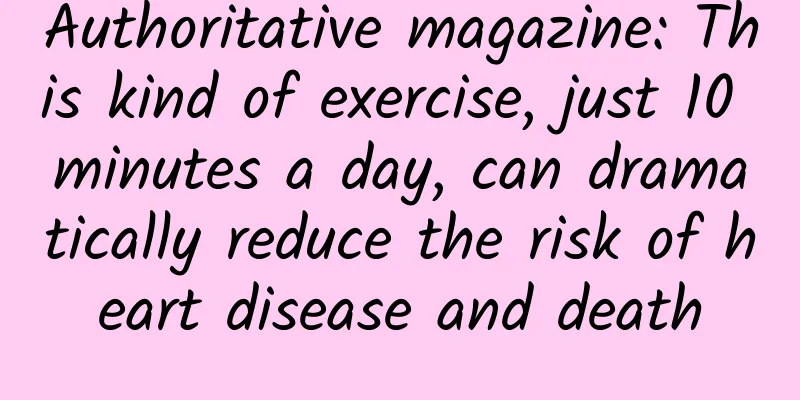Authoritative magazine: This kind of exercise, just 10 minutes a day, can dramatically reduce the risk of heart disease and death

|
Cardiovascular disease (CVD) is the leading cause of death in the world and also the leading cause of death in my country. According to statistics from the World Health Organization, nearly 18 million people die from cardiovascular disease each year, accounting for more than 30% of the total number of deaths worldwide. The high mortality and morbidity rates of cardiovascular disease are a major global public health issue that urgently needs to be addressed. Recently, researchers from the University of Sydney in Australia and the University of Oxford in the UK published a research paper titled "Brief bouts of device-measured intermittent lifestyle physical activity and its association with major adverse cardiovascular events and mortality in people who do not exercise: a prospective cohort study" in "The Lancet Public Health", a subsidiary of The Lancet. In this study, researchers analyzed 25,241 participants in the UK Biobank database, aged between 42 and 78 years old. The participants' movement parameters were recorded by wearing accelerometers. The MV-ILPA duration was divided into: less than 1 minute, 1-3 minutes, 3-5 minutes, and 5-10 minutes. The relationship between moderate to vigorous intermittent exercise and major adverse cardiovascular events (MACE) and all-cause mortality was analyzed. Overall, 824 major adverse cardiovascular events and 1111 deaths were recorded during the 8-year follow-up. Among all participants, the average duration of MV-ILPA per day was 26.8 minutes, with 59.7% having bouts of less than 1 minute, 27.5% having bouts lasting 1-3 minutes, 5.7% having bouts lasting 3-5 minutes, and 4.4% having bouts lasting 5-10 minutes. The analysis found that those with bouts of less than 1 minute had a 4.28% risk of death within 5 years, those with bouts lasting 1-3 minutes had a 2.83% risk of death within 5 years, those with bouts lasting 3-5 minutes had a 2.43% risk of death within 5 years, and those with bouts lasting 5-10 minutes had a 2.09% risk of death within 5 years. At the same time, people whose bouts lasted less than 1 minute had a 3.5% risk of major adverse cardiovascular events within 5 years, people whose bouts lasted 1-3 minutes had a 2.27% risk of major adverse cardiovascular events within 5 years, people whose bouts lasted 3-5 minutes had a 2.07% risk of major adverse cardiovascular events within 5 years, and people whose bouts lasted 5-10 minutes had a 2.06% risk of major adverse cardiovascular events within 5 years. The study found that compared with people whose bouts lasted less than 1 minute, those who had bouts lasting 1-3 minutes had a 34% lower risk of death, those who had bouts lasting 3-5 minutes had a 44% lower risk of death, and those who had bouts lasting 5-10 minutes had a 52% lower risk of death. For major adverse cardiovascular events, compared with those with bouts of less than 1 minute, those who lasted 1-3 minutes per bout had a 29% lower risk of major adverse cardiovascular events, those who lasted 3-5 minutes per bout had a 38% lower risk of major adverse cardiovascular events, and those who lasted 5-10 minutes per bout had a 41% lower risk of major adverse cardiovascular events. Association of MV-ILPA with all-cause mortality and MACE In addition, the researchers found that among people whose bouts were less than 1 minute, exercise duration of less than 1 minute also provided benefits, reducing the risk of major adverse cardiovascular events and all-cause mortality, when high-intensity exercise accounted for at least 15% of the total MV-ILPA duration. The researchers said the study showed that moderate to vigorous intermittent exercise can reduce the risk of major cardiac events. If possible, it is best to exercise for 3-5 minutes each time, which can significantly reduce the risk of major adverse cardiovascular events and all-cause mortality. Still, the researchers stress that this is an observational study and cannot establish cause and effect, and the take-home message here is that any type of exercise is good for health, but the more effort you put in and the longer you do it, the greater the benefits. In summary, the results suggest that 5 to 10 minutes of moderate to vigorous intermittent exercise per day can acutely reduce the risk of major adverse cardiovascular events and all-cause mortality. Paper link: https://doi.org/10.1016/S2468-2667 (23)00183-4 |
>>: Wearing pajamas VS sleeping naked, which is healthier? The truth is surprising
Recommend
Can pregnant women brush their teeth after giving birth? What should they pay attention to?
We all know that mothers will suffer a lot during...
Colorful food suitable for patients with cardiovascular and cerebrovascular diseases
Author: Qin Lili, Jining First People's Hospi...
What to do if there is a peculiar smell in the lower vagina
Some women will encounter a very embarrassing thi...
The reason why my aunt has diarrhea during her period
Menstruation is a physiological phenomenon of wom...
Can I do strenuous exercise while breastfeeding?
You cannot do strenuous exercise during the breas...
How high is the altitude of Ali in Tibet? How is the sweet tea drunk by Tibetans in Tibet made?
The Tibet Autonomous Region, abbreviated as Tibet...
How to apply light eyeshadow
I am about to attend the company's annual mee...
What should I do if I get infected after medical abortion?
After a medical abortion, even if the abortion is...
How long after giving birth can you wash your hair?
Women should not wash their hair or take a bath t...
What is the cause of long-term vaginal itching?
For many people, genital itching is a common symp...
Contraceptive success rate
The success rate of contraception with an IUD is ...
Why can't I wash off the "mud" on my neck? Doctor: This is not mud, be careful of these diseases
My friend was a little worried recently because h...









